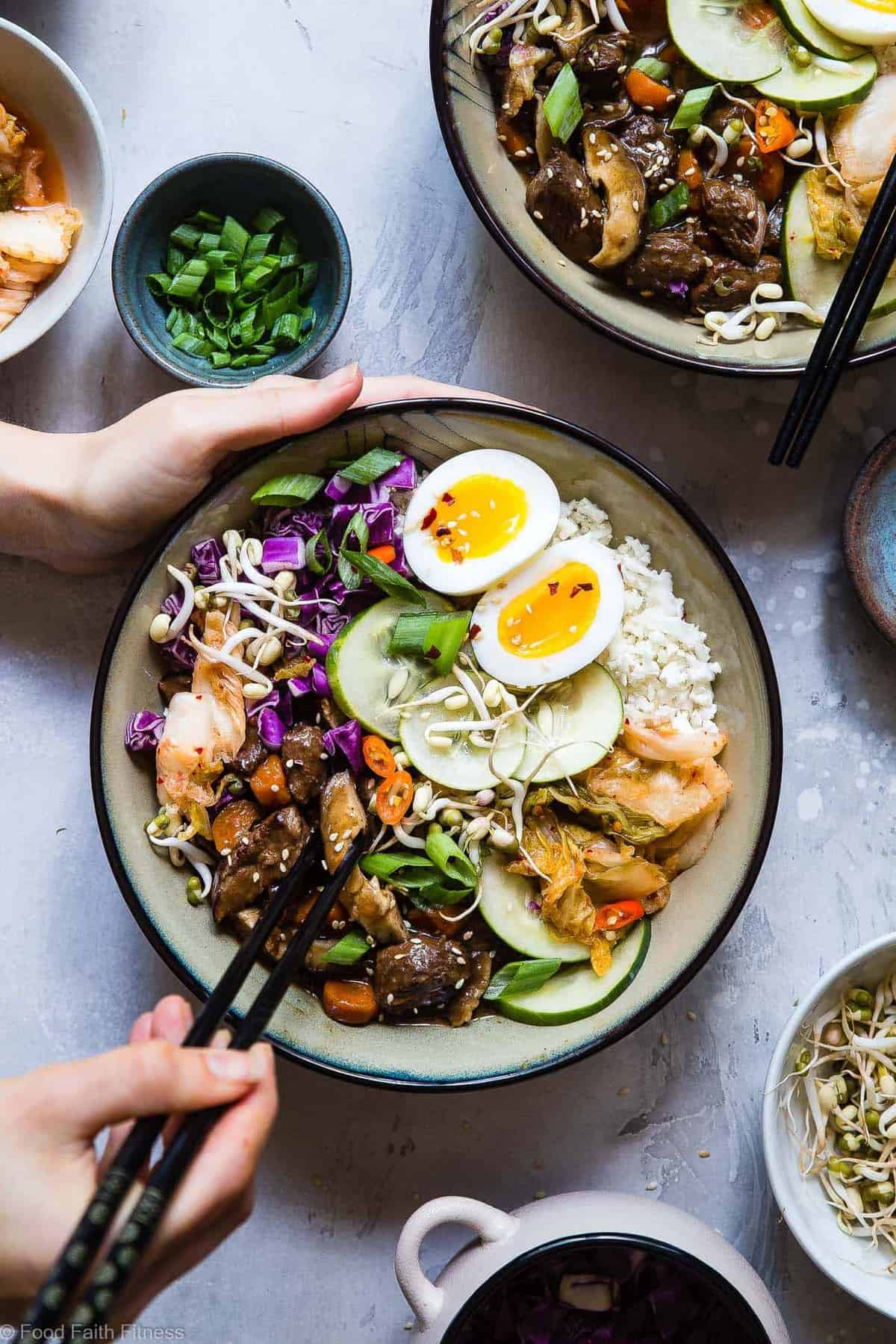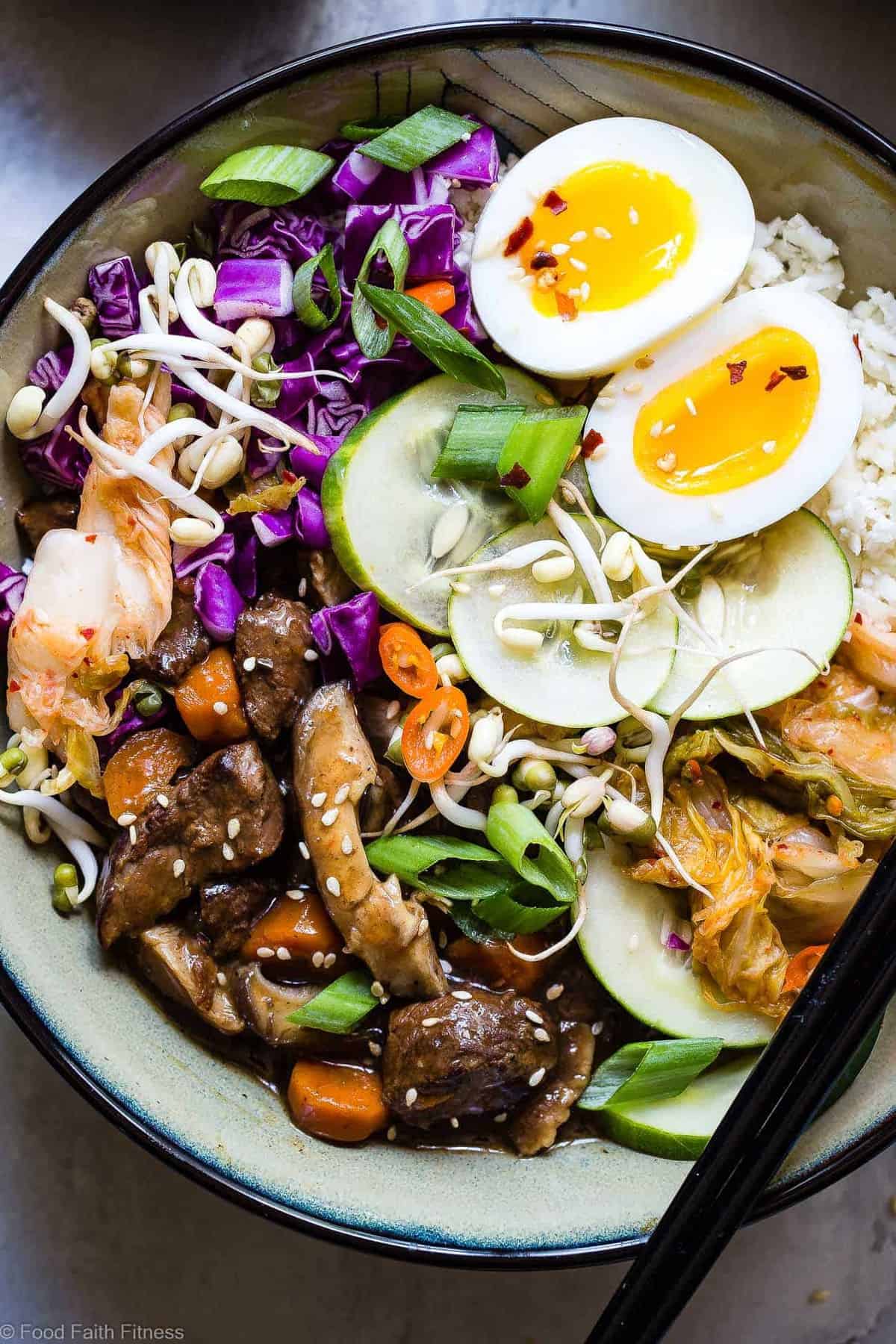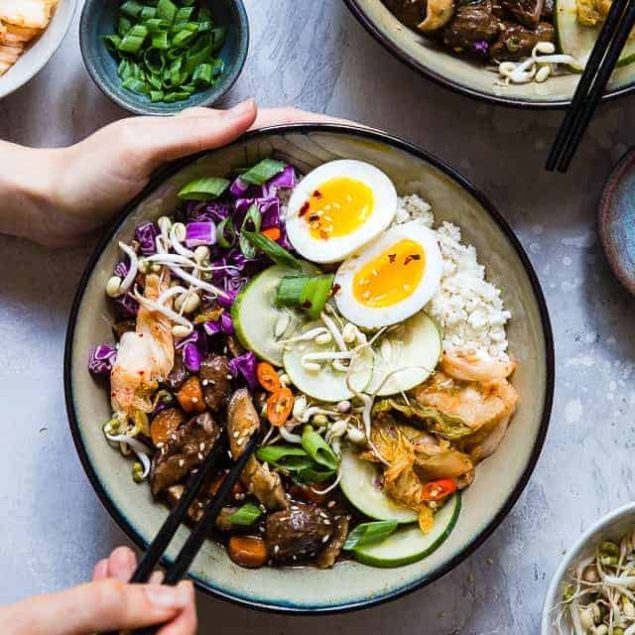This Slow -Cooker Paleo Korean Beef Stew dinner brings all the flavor with none of the weeknight stress!
If you’re like me, Korean food isn’t just a craving—it’s a staple. Seriously, I try to make it at least twice a month because nothing beats a good beef bulgogi with a side of homemade kimchi. Just typing these words provokes a Pavlovian response. In other words, I’m drooling over here.
But between freelancing, managing house projects, and shuttling three kids to various extracurriculars, firing up a grill for those perfect bulgogi edges isn’t always in the cards. That’s where my slow cooker steps in, ready to save the day.
I’m not saying this stew is bulgogi—it’s a stew. Still, it delivers similar flavors minus the fuss. Toss everything into your slow cooker, and come dinnertime, it’s Korean O’Clock. Put on some K-pop for good measure, or cue up your favorite Bong Joon-ho film (Parasite for me!) because this dish pairs perfectly with a cozy night in!
Whether you’ve enjoyed authentic Korean fare or not, I think you’ll appreciate this culinary homage. It’s basically a warm hug in a bowl. Like any good slow cooker recipe, the meat acts as a sponge, soaking up all those bold flavors—coconut aminos, spicy garlic chili paste, apple juice, and much more. I usually top this stew with kimchi, which is basically a zingy Korean sauerkraut. And let’s not forget the creamy, soft-boiled eggs. They’re the cherry on top of this umami-packed recipe!

Is This Slow-Cooker Paleo Korean Beef Stew Healthy?
Absolutely. For my Paleo and Whole30 friends, this stew provides plenty of protein and loads of veggies, all while keeping the carbs low. Similar recipes typically call for salty sauce and sugar, but we’re sticking with coconut aminos and apple juice.
Not into beef? No worries! I’ve made this recipe with chicken thighs and pork shoulder as well! Both soak up those umami flavors just as beautifully.
Why Coconut Aminos?
Coconut aminos—have you ever heard of them? Well, you have now! I first heard of coconut aminos when I was on an elimination diet (think Whole30), trying to figure out what the heck was going on with my gut. Luckily, soy sauce wasn’t a trigger for me—I love the stuff. However, I also realized that coconut aminos, while healthy, also make an excellent base for sauces and marinades.
So, what do coconut aminos taste like? Not like soy sauce! They bring a slightly sweet, milder flavor and seem to amplify other spices and sauces as they do for this slow cooker recipe.
Coconut aminos are also a fantastic option if you’re currently Paleo or Whole30! They’re significantly lower in sodium and don’t contain soy or wheat. In fact, feel free to use coconut aminos for any recipe that requires soy sauce. It’s a deliciously worthy swap.

How To Make Ahead And Store
For this recipe, store any leftovers in an airtight container in the fridge for up to 3 days. In my not-so-humble opinion, slow-cooker recipes taste even better a day or two after, so you’re in for a treat! Just be sure to reheat gently on the stovetop. That should keep the beef melt-in-your-mouth tender.

Serving Suggestions
This stew is fantastic served over cauliflower rice if you’re going Paleo, but regular Steamed Rice or brown rice work as well. Aside from the garnish mentioned in the recipe, I’d also recommend Cucumber Kimchi (Oi Kimchi) as another tangy and tasty option. Speaking of cucumbers, I love this Korean Pickled Cucumbers (Oi Muchim) recipe. It brings a little heat, and they’re pretty simple to make. Plus, you can put it on other Korean dishes like Bibimbap!
Recipe

Ingredients
For the stew:
- 1/2 tablespoon sesame oil
- 1/2 tablespoon avocado oil
- 1 pound grass-fed lean stew beef cut into 1-inch cubes
- 8 teaspoons tapioca starch divided
- 3 large carrots sliced
- 3/4 cup beef broth
- 3/4 cup apple juice (not from concentrate)
- 1/2 cup coconut aminos (or soy sauce)
- 2 teaspoons fresh garlic minced
- 2 teaspoons fresh ginger minced
- 2 teaspoons chili paste (or sriracha)
- 1/4 teaspoon ground black pepper
- 3 cup shiitake mushrooms sliced (4 ounces)
- 4 large eggs
- Cooked cauliflower rice or white rice
For the pickled cucumbers:
- 1/2 cup rice vinegar
- 1 cup apple juice
- 1 medium cucumber thinly sliced
Garnishes:
- Kimchi (sugar-free)
- Pickled cucumber (see recipe in instructions)
- Seasame seeds
- Bean sprouts
- Green onion sliced
- Red Cabbage (optional)
Instructions
- Heat the sesame oil and avocado oil in a large pan on high heat. Add in the beef and cook until golden brown on all sides. Transfer to a 7-quart slow cooker.

- Add 4 teaspoons of the tapioca starch, reserving the rest for later, and stir to coat the beef. Then add the carrot, broth, apple juice, coconut aminos, garlic, ginger, chili paste, and pepper. Stir to combine.
- Cover and cook on LOW for 6 hours.
- Stir together the rice vinegar and apple juice, and add the sliced cucumber into it. Cover and refrigerate while the beef cooks.
- After 6 hours, place the remaining 4 teaspoons of tapioca starch in a small bowl. Add 8 teaspoons of the hot cooking liquid and whisk until smooth. While constantly whisking, stir the mixture back into the slow cooker until combined. Add the mushrooms and stir. Cover and cook until the meat and mushrooms are tender, about 2 more hours.
- Bring a large pot of water to a boil (make sure you have enough water to cover the eggs). Once boiling, use a slotted spoon to gently place the eggs in the water. Cook for 7 minutes, then drain the hot water and cover the eggs with cold water.
- Serve over hot cooked cauliflower rice (or regular rice) and garnish with the cucumbers (drain the vinegar/juice out!), kimchi, sesame seeds, green onion, bean sprouts, and optional red cabbage. Peel the eggs and slice them on top.

- Enjoy!
Nutrition Info:
Recipes written and produced on Food Faith Fitness are for informational purposes only.



Can you freeze this before cooking?
Yes, you can freeze the prepared ingredients before cooking, but it’s best to freeze the beef, carrots, and liquids separately from the garnishes and cucumbers. Enjoy!
This was an excellent recipe!! I have added this to my own binder for suppers, and will make this many times again in the future.
(Note: It’s good even without the apple juice.)
So glad you liked it Taina, and thanks for letting me know about the apple juice